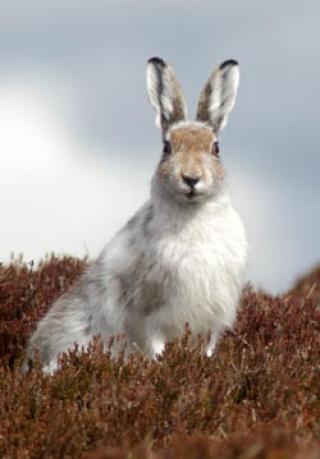Insufficient Evidence For Culling Mountain Hares For Tick And Louping-Ill Virus (LIV) Control
Published on 29 June 2010 in Ecosystems and biodiversity
Introduction
Mountain hares Lepus timidus and sheep have been implicated in the transmission of the louping ill virus (LIV) to red grouse Lagopus lagopus scoticus, which have been in long-term decline. LIV is a flavivirus transmitted by sheep ticks Ixodes ricinus and can cause high mortality in infected red grouse chicks reducing grouse density and the associated revenues from shooting. Therefore, controlling LIV is considered to be important for the continued financial viability of estates managed for grouse shooting. Although mountain hares do not show clinical symptoms of LIV, they are hosts for ticks, and laboratory trials have shown that non-viraemic tick to tick transmission of LIV (i.e. through the skin between ticks feeding close together, rather than via the blood system) can occur when they co-feed on mountain hares.
While culling mountain hare was associated with a decrease in ticks and LIV prevalence, and an increase in grouse numbers in one study carried out in Morayshire, the study site was unusual in that LIV prevalence was initially very high, grouse numbers were low, and there were very few deer present. The results from this one study have been widely interpreted as demonstrating that culling mountain hares is an effective management strategy to control ticks, LIV and increase grouse numbers. As a consequence, some moorland managers have increased culling of mountain hares, in the belief that this could be an effective management strategy to control ticks and LIV.
Key Points
Mountain hares are a UK Biodiversity Action Plan species, and listed in Annex V of the EC Habitats Directive (1992), as a species 'of community interest whose taking in the wild and exploitation may be subject to management measures' which requires Member States to ensure the conservation status of mountain hares is maintained and that their populations are managed sustainably.
Mountain hare populations are under threat from habitat loss, fragmentation, and over-exploitation and are thought to have declined in numbers and range in the UK. Long-term climate change is likely to adversely influence the sub-arctic/alpine habitats favoured by mountain hares.
Mountain hares are an important quarry and prey species, and as a numerous and widespread herbivore in the uplands play an important but unexplored role in shaping upland habitats and predator communities.
There is evidence to suggest that the killing of mountain hares for reasons of control has recently increased. During the period 2006/07 50% of mountain hares killed were killed as part of tick control measures, 40% killed for sport and 10% killed for crop/forestry protection. This compares to the period 1995/06 when 60% of hares killed were killed for sporting interest and 40% were killed for control.
The evidence that has been used to support the culling of mountain hares to control ticks, LIV and increase grouse densities is limited and equivocal.
Research Undertaken
We reviewed the available published studies on the interactions between ticks, LIV, red grouse and mountain hares to assess the evidence that culling mountain hares is an effective and practical way to control louping ill virus in red grouse.
The evidence that culling hares can decrease tick numbers and LIV prevalence, and increase grouse numbers is limited. Only one study has investigated the associations between ticks, LIV, hare density and grouse density, restricting our ability to reliably assess the effectiveness of culling mountain hares to control ticks, louping ill virus, or increase red grouse densities. Furthermore, the information required to assess the cost-benefit of this management strategy is lacking. The population response of mountain hares to culling is not well understood and the possible effects on their conservation status and the upland ecosystem remain unexplored. However, where alternative tick hosts are present there is strong evidence that culling mountain hares will not have any significant affect on ticks, LIV or grouse numbers.
Our conclusion is that there is currently insufficient evidence to provide scientific justification for culling of this Annex V species for the purposes of tick and LIV control, with the purpose of increasing red grouse numbers.
Policy Implications
Along with culling, mountain hare populations face threats from climate change and habitat loss. This has led to the mountain hare being included on the UK Biodiversity Plan list of priority species. Mountain hares are also listed on Annex V of the EC Habitats Directive which aims to conserve natural habitats and wild fauna and flora, and requires Member States to take measures to ensure mountain hare populations are maintained at favourable conservation levels.
In parts of Scotland the grouse shooting industry can be crucial to livelihoods and the local economy. Ticks and LIV are perceived by grouse moor managers to be one of the most important current issues in the Scottish uplands and one of the biggest threats to their livelihoods. Despite this and in the face of their deteriorating conservation status, culling of mountain hares as part of an unproven strategy to control ticks and LIV and improve grouse numbers has to be questioned. This is both in terms of the potential impact on the conservation status of mountain hares and the efficacy of culling as a control strategy. This work highlights a number of knowledge gaps, some of which are being addressed by current RERAD and NERC-funded research.
Author
Scott Newey, Lucy Gilbert, Annabel Harrison s.newey@macaulay.ac.uk
Topics
Ecosystems and biodiversity
Comments or Questions








